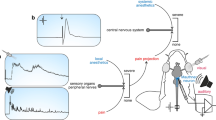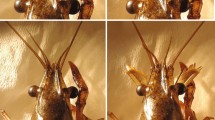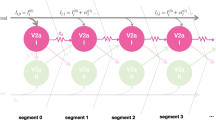Abstract
A new technique of multiple-air-gap recording was developed to study the EO activation process in Gymnotus carapo. Using this technique, the spatiotemporal pattern of electromotive force generation was investigated in normal and spinal-lesioned animals.
Our data indicate that the EOD may be considered as the result of the sequential activation of 3 defined portions of the EO: the abdominal portion (included in the rostral 25% of the fish body), the central portion (comprising the intermediate 50% of the fish body) and the tail portion (the caudal 25% of the fish body). The EOD generated at each portion is characterized by: 1) timing respect to the pacemaker nucleus discharge, 2) speed of progression within the region, 3) waveform, and 4) magnitude.
Spinal sections demonstrated that EMNs serving relatively small portions of the EO are widely distributed (convergence) and that surgical exclusion of relatively small portions of the spinal cord diminishes the amplitude of the EOD along an extended portion of the EO (divergence).
Similar content being viewed by others
Abbreviations
- EMF:
-
electromotive force
- EMN:
-
electromotor-neurons
- EO:
-
electric organ
- EOD:
-
electric organ discharge
- PMNFP:
-
pacemaker nucleus field potential
- PEN:
-
posterior electromotor nerve
- PNA:
-
peripheral neural activity
References
Albe-Fessard D, Buser P (1950) Etude de l'interaction par champ électrique entre deux fragments d'organe de Torpille (Torpedo marmorata). J Physiol (Paris) 42:528–529
Albe-Fessard D, Martins-Ferreira H (1953) Role de la commande nerveuse dans la synchronization du fonctionnement des éléments de l'organ électrique du Gymnote, Electrophorus electricus L. J Physiol (Paris) 45:533–546
Bastian J (1986) Electrolocation: behavior, anatomy and physiology. In: Bullock TH, Heiligenberg W (eds) Electroreception. John Wiley & Sons, New York, pp 577–612
Bell C (1989) Sensory coding and corollary discharge effects in mormyrid electric fish. J Exp Biol 146:229–253
Bell CC, Bradbury J, Russell CJ (1976) The electric organ of a mormyrid as a current and voltage source. J Comp Physiol 110:65–88
Bennett MVL, Grundfest H (1959) Electrophysiology of electric organ in Gymnotus carapo. J Gen Physiol 42:1067–1104
Bennett MVL, Pappas GD, Giménez M, Nakajima Y (1967) Physiology and ultrastructure of electrotonic junctions. IV. Medullary electromotor nuclei in gymnotid fish. J Neurophysiol 30:236–300
Caputi A, Macadar O, Trujillo-Cenóz O (1989) Waveform generation in Gymnotus carapo. III. Analysis of the fish body as an electric source. J Comp Physiol A 165:361–370
Caputi A, Silva A, Macadar O (1990) Sincronizacion del sector distal del órgano eléctrico en Gymnotus carapo. Res V Jornadas de la Sociedad Uruguaya de Biociencias. pp 82
Cox RT, Coates CW, Brown MV (1945) Relations between the structure, electrical characteristics and chemical processes of electric tissue. J Gen Physiol 28:187–212
Donaldson PEK (1958) Electronic apparatus for biological research. Butterworth, London
Fessard A (1958) Les organes électriques. In: Grasse P (ed) Traité de Zoologie, T. XIII. Masson, Paris, pp 1143–1238
Lissmann HW (1951) Continuous electrical signals from the tail of a fish, Gymnarchus niloticus Cuv. Nature (Lond) 167:201–202
Macadar O, Lorenzo D, Velluti JC (1989) Waveform generation of the electric organ discharge in Gymnotus carapo. II. Electrophysiological properties of single electrocytes. J Comp Physiol A 165:353–360
Trujillo-Cenóz O, Echagüe JA (1989) Waveform generation of the electric organ discharge in Gymnotus carapo. I. Morphology and innervation of the electric organ. J Comp Physiol A 165:343–351
Trujillo-Cenóz O, Echagüe JA, Macadar O (1984) Innervation pattern and electric organ discharge waveform in Gymnotus carapos. J Neurobiol 15:273–281
Author information
Authors and Affiliations
Rights and permissions
About this article
Cite this article
Caputi, A., Silva, A. & Macadar, O. Electric organ activation in Gymnotus carapo: Spinal origin and peripheral mechanisms. J Comp Physiol A 173, 227–232 (1993). https://doi.org/10.1007/BF00192981
Accepted:
Issue Date:
DOI: https://doi.org/10.1007/BF00192981




